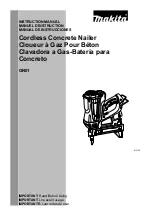
1.
Important Safety Instructions
This manual should be read carefully and understood completely by any person who intends to operate this
tool. All instructions given should be adhered to accordingly as failure to comply may result in serious
damage to the operator and/or the tool. The employer is responsible for enforcing the use of safety protection
equipment by the tool operator and all other personnel in the work area.
Use safety glasses:
all persons in the work area must always wear safety glasses in order to prevent eye
injuries.
Ear protection
must also be worn to prevent a possible hearing loss.
Use clean dry regulated compressed air
at the recommended pressure (given in the technical data).
Use only fasteners
made or recommended by the tool manufacturer (refer also to the technical data).
Never
exceed the maximum recommended operating pressure of this tool.
Never
use oxygen, carbon dioxide, combustible gases or any bottled gas as a power source.
Always disconnect
the air supply when doing any tool maintenance, cleaning a jam, moving location,
leaving the work area or passing the tool.
Regularly inspect
the safety, the trigger and the springs for free unhindered movement, never use a tool
that requires servicing.
Connect
the male free flow nipple to the tool side of the airline so that the tool is depressurized when
disconnected from the hose.
Never
load fasteners with the trigger safety depressed as if the safety is bumped it will result in a fastener
being fired.
Never
carry the tool with the safety depressed as if the safety is bumped then it will result in a faster being
fired.
Never
point the tool at yourself or at any one else.
Never
fire a fastener into a hard brittle surface such as concrete, steel or tiles.
Do not drive
fasteners too close to an edge or at too great an angle as the fastener may fly free or ricochet
causing personal injury and damage.
Always
ensure that the work area is amply lit so as to avoid possible accidents caused by bad light.
Never
remove, tamper with or otherwise cause the tools operating controls to become inoperable.
2. Compressed Air System
Proper use of the fastener driving tool requires an adequate quantity of clean dry compressed air. All
compressed air contains moisture and other contaminants detrimental to the tool and so it is recommended to
use an airline filter regulator lubricator as close to the tool as possible (within 15 feet (4.5m)). The filter
should be well maintained so as to ensure optimum performance and power. All parts of the air supply
system should be clean and contaminant free.
The tool shall only be connected to a compressed air line where the maximum allowable pressure cannot be
exceeded by a factor of more than 10%, which can for example be achieved by a pressure reduction valve
which includes a downstream safety valve.
A male free flow coupling should be connected to the tool side of the system with the female coupling
providing a seal to prevent air loss from the compressor tank upon disconnection. Never connect a female
disconnect coupling to the tool side as this provides a seal which prevents loss of compressed air from the air
tank and if connected to the tool it could seal a charge of air in the tool which could lead to an unintentional
actuation. Do not mount a swivel connector in the air supply line.
Different work pieces will require different operating pressures, the harder the wood the greater the pressure
required. Remember always use the lowest pressure required for the work process at hand, this being to
prevent unnecessarily high noise levels, increased wear and resulting failures.
WARNING Keep hands and body away from the discharge area of the tool when connecting the air supply and
always disconnect the tool when servicing, adjusting, cleaning and when the tool is not in use.





























